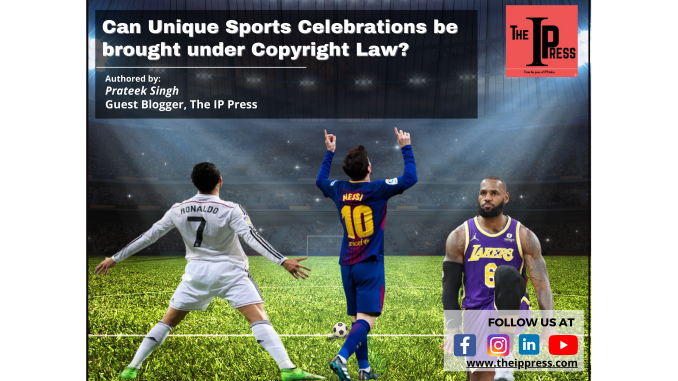
Sports, especially in the current time have become much more than just the sport itself. The billions of dollars worth of industry/clubs, financially outrageous advertising deals for the top athletes, worldwide following from fans that follow these individuals religiously and a larger than life persona of those individuals are a few of the things that add a different and interesting spice to these sporting events. However, one more thing that connects these icons with their fans in a symbolic way. The unique and powerful celebrations they showcase in their respective fields are pleasing to the adrenaline. Be it Cristiano Ronaldo’s running towards the edge of the pitch, jumping and spinning 180 ° before landing on a wide-legged stance and screaming “SIIIUUUU”, Lionel Messi’s pointing index fingers from both hands towards the sky, LeBron James’s ‘Silencer’ or Conor McGregor’s ‘Billy Strut’, they all strengthen the bond between the athletes and their followers by allowing them to replicate something that their idol or star does.
Importance of sports celebrations
These celebrations are so popular and are such a statement, that you will see athletes from different fields attempting these as their celebratory move. It can be termed as ‘copying’ but often they are paying homage or doing it out of sheer respect for the original. These celebratory moves are so iconic that they are etched in the minds of followers and from other celebrities to regular people, everyone tries their best to imitate them at any chance they get.
An athlete’s career span is usually 10-15 years barring the exceptions of those who manage to add a few more years to it. In that short span, they work round the clock to make a name for themselves and make a fortune out of that career. Events like these celebrations are extremely merchandise friendly, something the fans wear or own with pride. Every year Forbes releases a list of ‘Highest-Paid Athletes’, and it is a common sight that the athletes make more money from outside the pitch (brand deals, endorsements etc.) as compared to what they earn through match fees. Does this call for serious thoughts about whether there is a chance that these athletes are missing out on cashing those events? How can these moves be brought under copyright? Under what umbrella can this be brought to the law?
Style of Celebration & Style of Playing: The Difference
Style of celebration and the style of playing the game are two different terms and have a completely different alliances to the game. Style of celebration is an expression of their self, at that moment where they feel like they are unbeatable, at the best of their game and the demonstration of that feeling is truly their own, designed to suit their persona on the playing field. On the other hand, the style of playing or the special moves that they have invented is a part of the game, example: when Indian Men’s Cricket Team legend MS Dhoni hits his iconic ‘Helicopter Shot’ to secure a shot on a yorker-length ball or Portuguese Football Superstar Cristiano Ronaldo performs the ‘Ronaldo Chop’. The style of celebration can be protected under law but the latter cannot be as it adds value to the game being played. When someone copies the same style of playing as someone else, they are making the game interesting and more skilful.
Unauthorized use and the harm
Numerous market players run websites selling products from t-shirts, and hoodies to phone covers which often have pictures from the same celebratory moves. The situation is not restricted to just these websites, local shops that only operate in regional areas print the same material and sell it for profit. It is an extremely common sight to come across where one such product is donned by a follower or even an unaware individual. This is a clear violation of someone’s intellectual property law and there needs to be a law in place for the same.
India’s Governing Law and the Element of Originality
Section 2(q) of the Copyright Act, 1957 talks about rights about ‘performance’. The performance can be visual, live and made by one or a group of performers. Section 2(qq) of the Act defines ‘performer’ which also includes an acrobat, a gymnastics based sport. It does not appear to be a far-reaching argument when you put sports into the category of performance. These athletes put on a show, a spectacle for the viewers to enjoy and everything about the way a sport is played in the current time is entertaining and nail-biting to its very core.
The styles of celebration by these athletes are original and an expression of themselves designed personally to convey their motives through actions. These celebratory moves can be termed choreographed moves because choreography comprises a sequence of steps and movements. Law does protect choreographed acts. Section 2(h) of the Act says “dramatic work” includes any piece of recitation, choreographic work or entertainment in a dumb show, the scenic arrangement or acting, form of which is fixed in writing or otherwise but does not include a cinematograph film.
There have been several cases that support this contention. In Baltimore Orioles Inc. v. Major League Baseball Players Association case, the court disagreed with the argument that ‘performances by the players did not possess enough artistic merit to be made a copyrightable material’ and referred to its decision in Gelles Widmer Company v. Milton Bradley Co, where the court stated that “Only a modicum of creativity is required for a work to be copyrightable”. The originality of those celebratory moves consisting of movements and consequences makes it eligible to be a copyrightable subject matter as a “dramatic work”.
Recommendations
There is no questioning the originality of the celebratory moves by the athletes. It is established from the arguments and examples above that there does exist scope for bringing them for protection under copyright law. Under the law, these celebratory moves can fit into the definition of ‘performance’ by a ‘performer’ and also under ‘dramatic work’ as a choreographed piece of art. This becomes all the more important when looked at from a financial perspective. The ‘moves’ can easily be made profitable for the athletes and for the fact that they are the original creators of such moves, it is well within their rights that they are allowed to have ownership over them and use them in ways they please.

Prateek Singh
Author
Prateek is a 4th-year law student studying BA LLB (Hons.) at the Institute of Law, Nirma University. He is interested in IPR and Technology law.
I have an IP case the matter being a celebration of the faking it celebration and it has been used commercially by EA sports and no consent or compensation was given to the owner. Assist